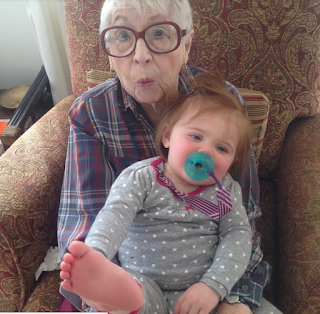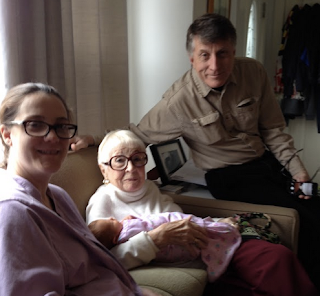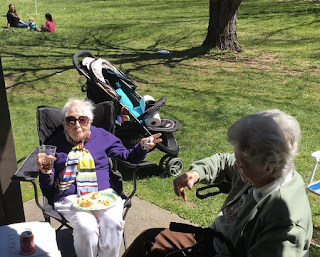Remembering Nancy Waters
Wednesday, March 10, 2021
For the Woman with the Red Glasses—Nancy M. Waters, November 26, 1925-February 12, 2021 by William Waters
We think this is how Mom would have liked to be remembered. She probably would have appreciated a soundtrack including her favorite hymns, “In the Garden” and “Softly and Tenderly,” the Art Garfunkel hit “Bridge Over Troubled Water,” and the moving standards of “America the Beautiful” and “O Danny Boy.” (Maybe you can find a YouTube or ask Alexa.) What follows is a short biography gathered from the stories she enjoyed sharing with her flair for poignance, her unfailing generosity, and her always ready sense of humor. Please forgive any omissions you might sense, as it is doubtless many have their own best memories of Nancy Waters. Be sure to share them. Beginning in November of 1925, Nancy McKinney’s entire girlhood was spent on South Potomac Street and the expanding reaches of the Highlandtown streets—age and adventure pushing from Patterson Park to “the avenue (Eastern that is)” and beyond. Only the occasional trips to the country to stay with her cousins the Bacons in Monkton, at “Bridge House,” intervened in summer days spent on the edge of Patterson Park, where the land rises just above the northern border of the park, Canton visible to the south. There were summer concerts at the bandstand, days at the public swimming pool, chores scrubbing the front steps and special errands to the corner store for a loaf of bread or a paddle full of butter and large pickles right out of the barrel. It was a time between two world wars and a devastating depression, but since her father always had work, it was also a time when a young girl could dream of a world much bigger and more complex than the orderly streets of neat row homes that followed the rolling hills above the Baltimore waterfront. All of these days she shared with her best friend June Elste whose house featured the same sparkling marble steps and stained-glass transom as every other house on the red bricked street. The two girls were inseparable and would remain close for over 80 years. They could dash through the front door, run the length of the houses only one room wide and meet in the back yards. Out through the back gate, between the rows of houses, the alleys teemed with their own life of hucksters, ice wagons, and fishmongers. Little Nancy took it all in with an eye which must have wondered where it all came from, surely badgering her mother with questions or curling up in her grandmother Mimi’s lap to hear stories about the Compton or the Bacon families. Her father, a compact serious man, set out every morning for the streetcar yard between Lombard Street and Eastern Avenue, where he’d take his place behind the controls of one of the cars that served the Roland Park line. His life was as mysterious to his daughter as the regalia he donned for his meetings at the Masonic Temple. It was a time when children were to be seen and not heard, and it seemed to Nancy that her little sister Dorothy, with her Shirley Temple ringlets of blond hair, was her parents’ favorite. Perhaps Nancy’s sense of mischief explained some of this, or was it the other way around? Often, she and June disappeared into the park until nightfall during the long days of summer. Sometimes this led to trouble, like the time the duo returned with their clothes ruined by the oily pigment of red clay, having spent the day sliding down the orange mounds piled at the edge of the park, possibly the clay used to resurface the tennis courts. There was another day when the girls came home to big trouble, well after dark, having hiked to the Mt. Carmel Cemetery on O’Donnell Street where rumor had it that the ground heaved up coffins and bodies were spilling out into plain view. They searched and searched the undisturbed graveyard, where the dead slept peacefully, until it was too late to make it home on time. Her mother Nan would not have peace in mind for her wayward child. During the school years the girls made their way to the towering, fortress-like building that housed Patterson Junior and Senior High School, where Nancy skipped second grade and managed to keep her nose clean. There were chores to be done after school and the family attended Highlandtown Methodist Church on Sundays. Saturdays were heavenly. With a dime or two in their pockets, the neighborhood kids could go to the Patterson or the Avenue theaters for the latest Jeanette MacDonald and Nelson Eddie feature. With each visit, the newsreels became more ominous as Hitler rose to power and the boys talked about signing up for the war effort. After graduation in 1942, those boys did go to war, and Nancy and June were accepted into nurses training and the U.S. Cadet Nurse Corps at Church Home and Hospital, moving to their new world in Baltimore’s Broadway East neighborhood. For the next three years they were thrust into an intense curriculum, assuming nursing duties almost immediately since so many RNs were serving abroad. Nancy worked hard and made her presence known, if not always for the best reasons. She told stories of dropping and breaking a gallon jar of tonsils soaking herself in formaldehyde and knocking a surgeon’s glasses into an open incision. And on another occasion, alone in the Phipps Clinic psychiatric unit, she was tackled by a large patient who sat on the diminutive trainee until help arrived. In calmer moments, Nancy and June would walk to upper Fells Point to take in a movie or shop for clothes for those rare opportunities when they could shed their white uniforms. They graduated as newly minted RNs who maintained a lifelong friendship sealed now by the rites of passage leading to their profession and a new world no longer at war. Soon the boys came home as men ready to get on with their lives, ready to meet new challenges, ready to settle down. One Sunday afternoon at a reception for the new pastor, Nancy met Army Pvt. William Waters, the dashing elder son of the preacher. Bill had just returned from the barracks of war in Europe, Nancy from the nursing school dormitory, and the love story began. They were married just before Christmas in 1947, a union that would last for the next 63 years. Her friend June fell in love as well, marrying Thomas Kelmartin, whose cheer and Irish good looks helped deepen the four-way friendship as Tom and Bill hit it off like old buddies. Children were soon to come. “Lady Bug” as they called their first child Susan, was born in July of 1950, and in September of 1952, Billy was born. In both cases, it was back to Church Home and Hospital, this time to be cared for by some of the same nurses who had trained Nancy a few years before. Now the family of four, having outgrown the Macbeth Drive apartment in Northeast Baltimore, found a suitable and brand new home in a Baltimore County development between Harford and Old Harford Roads in Parkville. This would be home for the next 19 years, where Nancy and Bill met a community of “Woodcroft” friends they retained for years. As original suburban settlers, they helped found the community swimming pool, played in the neighborhood bridge club, shared babysitting duties and worked hard to give their children a steady footing toward a new prosperity. Nancy met another friend for life who happened to share her November 26th birthday. Doris Forster and her husband Lewis would share all things in their Woodcroft lives then pack up for the summer and vacation together at Dewey Beach, Delaware. Eventually they would become next door neighbors at Dewey, when Nancy and Bill purchased a cottage that remains in the family as a Mecca Nancy hoped would always be there for her children, children’s children and more. Nancy was never content to be a traditional stay-at-home mom; she had worked hard training as a nurse, and she was intent on using those skills to care for others. Besides, Bill was working his way through grad school, and there were plenty of bills to be paid. She took a position as a school nurse at Loch Raven Elementary, which allowed her schedule to match her children’s. Later she spent nearly 20 years in downtown Baltimore where she worked for The Sun Life Insurance Company. There she doubled as a corporate nurse and as she described herself—“The Nurse to the Stars.” Since the insurance company was just a short walk to The Morris A. Mechanic Theater, the traveling shows contracted with Sun Life to offer medical services to the actors while in town. Mom was proud to report that she never once asked for an autograph, serving as the consummate professional rather than becoming star struck by celebrities including Dustin Hoffman, Katherine Hepburn, George C. Scott, Tony Randall, Vincent Price, Deborah Kerr and many, many others. As it turned out, Nancy and Ms. Kerr became friends who would exchange letters and cards for many years. When not working, Nancy loved to travel. She and Bill thought nothing of throwing the kids in the backseat of their fire engine red, 1957 Oldsmobile and driving cross country. In the mid-60s they took the kids on a whirlwind tour of Europe, where they bought a Volkswagen and shipped it home at the conclusion of their adventures. When they weren’t on the road, they enjoyed staying in one place at several Dude Ranches in upstate New York. Nancy struck quite a pose on horseback. Well not exactly. Filmed by her husband, in grainy 8mm, there was always a silent narration of panic and protest. She was much happier at poolside. As the kids went to college and made their way toward independence, Nancy enjoyed accompanying Bill on professional conferences all over the country and overseas. Later, and with friends including the Kelmartins and the Forsters, they took to the high seas aboard cruise ships sailing up and down the East Coast and in the Caribbean. When grandchildren came along, they eventually saw to it that the whole family, kids, spouses and grandkids, could cruise together. In 1973, Nancy and Bill sold the house in Woodcroft, said sad goodbyes to the beloved community of friends, and bought their second new home in Severna Park, Maryland, creating a shorter commute for Bill to Anacostia, Virginia, where he worked for the Naval Research Laboratory in the radar division. Nancy’s pride in her husband’s accomplishments was always clear; she allowed her lifelong medical career to operate quietly in this shadow, even as she diagnosed, prescribed, and treated everyone in her midst. Indeed, Nancy was a nurse practitioner before the profession was defined. She even took a stitch or two to the wounds of family pets. Nancy and Bill retired and followed their plan, moving to the Oak Crest Retirement Village community. In their early 80s, the move was a challenge, Bill having been challenged by heart failure for several years before the move and Nancy taking a nearly fatal tumble while painting a back porch window. After recovering and saying goodbye to a second neighborhood of dear friends , they made the transition to a sunny, corner apartment at the sprawling senior community, where they found themselves participants in a kind of reunion. Their neighbors and dining partners included dear friends from Woodcroft, neighbors on Macbeth Drive, schoolmates from Church Home and Johns Hopkins, and later, rejoined friends from the Hillendale neighborhood in Severna Park. Until Bill’s death in 2011, they were a beloved couple who brightened up the community and enjoyed the well-earned rest from the daily chores of home ownership. Nancy continued to host Christmas gatherings in the apartment, and enjoyed the overnight stays when her niece would visit from Long Island, often drifting off to sleep as her Aunt Nancy embellished the family history. In the years following Bill’s passing, Nancy never felt sorry for herself, assuming her role as the family matriarch who would enjoy the successes of her two children in their long teaching careers, witness the marriages of her two grandchildren, and celebrate the birth of four great grandchildren. All the while, she became well known in the Oak Crest community as the woman with the flamboyant red glasses, who spoke her mind, could be delightfully irreverent, and never missed an opportunity to pay perfect strangers a compliment. When Nancy joined her table for dinner, everyone knew the conversation would become lively and entertaining. It wasn’t as if she believed herself to be the “belle of the ball,” she just wanted everyone around her to be happy. This wish for others’ wellbeing would be her final career, one to which she was as dedicated as she was to nursing and motherhood. Even as memory and mental clarity slipped away, she wanted nothing more than to know, moment by moment, that the people she loved were doing well, and she pursued her worries about this with a professional intensity. So, to distract herself from these anxieties, she continued polishing her wonderful sense of humor and generosity of spirit to the very end. She made yet another dear friend, Merle, with whom she shared meals and quiet time sitting in the commons rooms of the Oak Crest memory care unity where she lived her last months. She was aware enough to be glad Joe Biden was elected President, distressed that the whole world was suffering from the COVID-19 pandemic, and reassured that she was loved and not forgotten. According to the caregivers, on her last morning she was joking with the staff when she drifted into her last sleep. Nancy Waters lived the definition of a good life, and without a doubt, from some place of rest, she is wishing the same for us all.




























